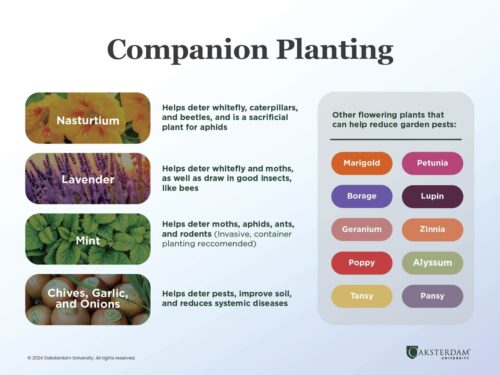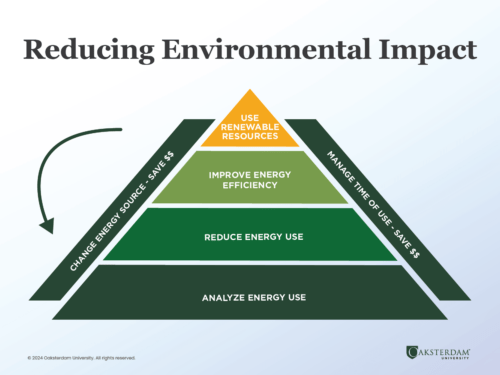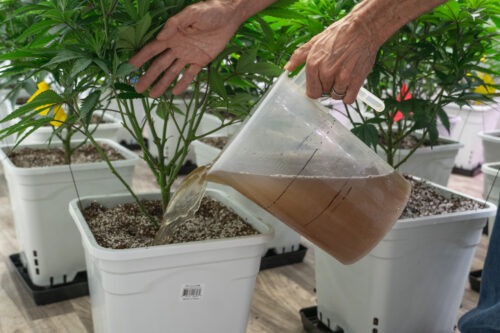Growing cannabis at home is cheaper and more rewarding, but is it sustainable? Learn how to grow cannabis sustainably with Oaksterdam! Like all other types of agriculture, cannabis can be grown with sustainability in mind. It can also be incredibly destructive. Some elements of the commercial cannabis industry have become unsustainable by law. For example, many regions require lockable plastic bags for all products sold in a dispensary, which are typically single-use. Many standard cultural practices that arose among growers from the pre-regulated era, such as a reliance on bottled liquid nutrients, are also unsustainable.
Energy consumption is another major stumbling block for indoor and greenhouse cultivation sustainability. Creating the “sunshine” necessary for a healthy harvest requires energy-intensive artificial lighting. Other electrically-powered systems found in indoor and greenhouse environments, such as climate control and ventilation, add significant weight to the overall carbon footprint of these growing methods. However, several technological advances have been made that can reduce the heavy reliance on fossil fuels to create artificial growing environments, such as more energy-efficient LED lighting and HVAC systems, and on-site renewable power generation.

Companion planting is a good option for cannabis sustainability.
Outdoor cannabis production, on the other hand, relies on the natural resources of the sunshine, water, and soil at the grow site. Responsible stewardship of these resources can be incorporated into a conservationist and regenerative approach to farming, but irresponsible practices can cause massive ecological damage.
In dense outdoor cannabis-growing regions like California’s Emerald Triangle, for example, pollution of the watershed from non-organic inputs used in cannabis production has prompted the enactment of regulations limiting the usage of water for cannabis cultivation. It is important to note, nevertheless, that cannabis cultivation is not the only industry responsible for this type of ecological damage. There is a combined effect of agricultural production, the built environment, and waste generation that lands ALL types of farmers in the same conundrum.
Home Grow Sustainably
Oaksterdam’s Home Grow course presents techniques and concepts encompassing all growing methodologies, from indoor tents to outdoor gardens. Home cultivation presents a pathway to cannabis freedom for many people. At the same time, it is our collective responsibility to grow cannabis as sustainably as possible.
Indoor cannabis cultivation is incredibly resource-intensive. From the cash outlay to procure the growing equipment to the increase in both the physical (e.g., utility bill increase) and environmental (e.g., fossil-fuel consumption) costs, indoor cultivation is more impactful than outdoor growing. If you must grow indoors, we encourage you to take steps to cut down on your energy consumption and the amount of materials you use, particularly plastic.

Sustainability and cannabis CAN go hand in hand.
Water and Energy Conservation
Cannabis plants require abundant water and light to achieve optimal growth. In an indoor garden or greenhouse with supplemental lighting, at least some of the lighting will be powered by electricity. The use of both water and electricity in cannabis cultivation can have a significant impact on the environment; using less of each is a relatively simple way to improve the sustainability of a cannabis garden.
Water conservation is the practice of responsible water consumption. It entails mitigating the excessive use of water and being mindful of the impact of tapping already taxed watersheds. Some standard water conservation techniques include reducing usage, reusing irrigation water and condensate from dehumidification systems, rainwater harvesting, establishing retention ponds, and employing permaculture techniques for maximum water retention in the soil.
Energy conservation is essential to reducing the carbon footprint of a cannabis garden, particularly an indoor site.
A Call to Action
Every home garden is unique to the site, and not all people will be able to grow outdoors to reduce their home garden’s carbon footprint. Whatever method of cannabis cultivation works best for your home, be it indoors or outside, please attempt to mitigate your consumption of resources, especially fossil fuels, as much as possible.
The cannabis movement is not just about the freedom to grow cannabis for personal consumption. It is about freedom in many forms. People fought for cannabis decriminalization, the process that made home cultivation legal, to free themselves from the oppression of the War on Drugs and, along the way, created underground economies that were networks of family-based cottage industries of craft cannabis cultivation.
Many of these cannabis pioneers were growers who cared deeply about preserving the land and waterways around their gardens. The spirit of the cannabis movement has always manifested sustainability, not just for ourselves but also for our communities and our ecosystem. We encourage you to continue this tradition in any way possible in your home cultivation journey.
